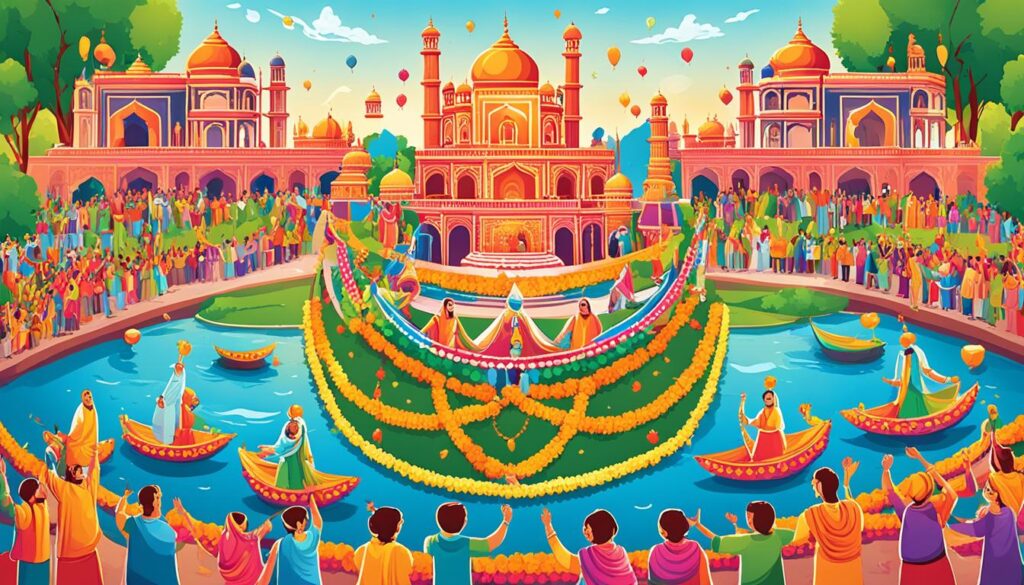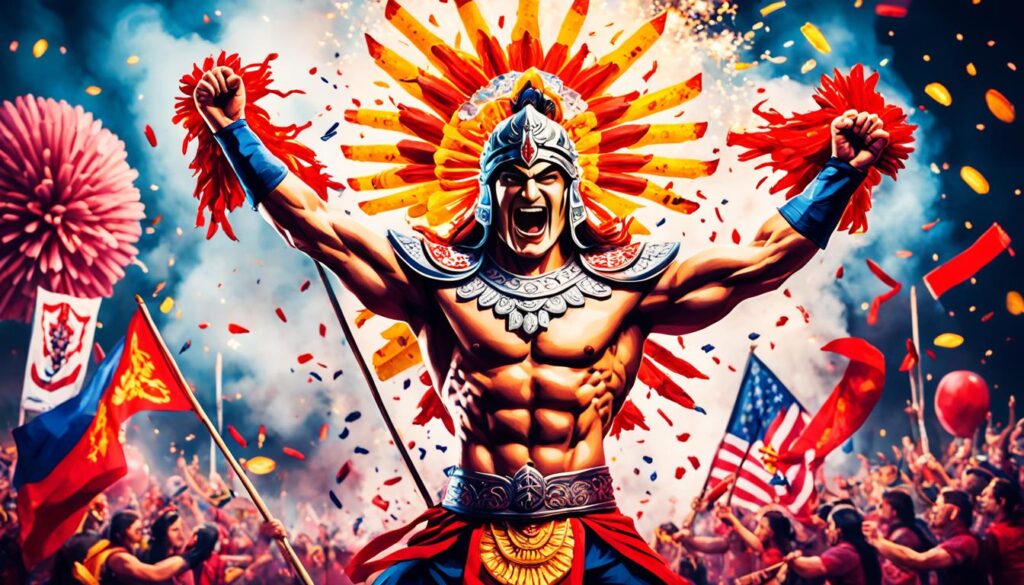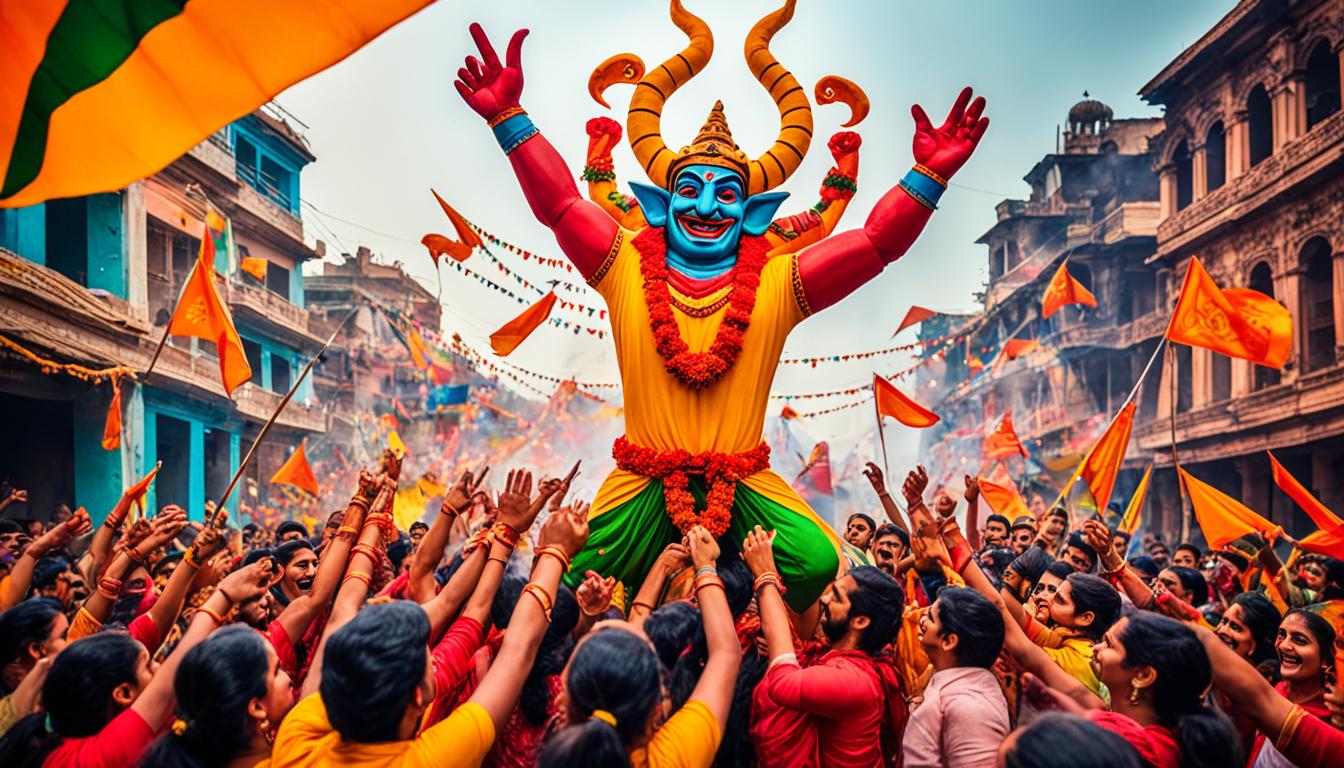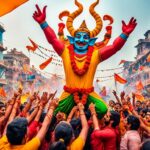As colors of autumn spread in India, celebrations light up the country for Vijayadashami, or Dussehra. This Hindu festival is marked by its meaning of triumph of good over evil. Why does it grab the hearts of millions each year?
Vijayadashami falls on the tenth day of the Hindu month Ashvin1. It’s usually between September and October on Western calendars. This day praises Durga’s victory over Mahishasura in the south and Rama’s triumph over Ravana in the north of India1.
This festival holds deep meanings and symbolism. Let’s dive into what Vijayadashami means for Hindus
Key Takeaways
- Vijayadashami marks the triumph of good over evil, commemorating the victories of Goddess Durga and Lord Rama.
- The festival is celebrated across India, with regional variations reflecting the diverse cultural traditions.
- Vijayadashami signifies the end of the nine-day Navaratri festival, honoring the divine feminine in all her forms.
- The festival emphasizes the importance of moral values, such as courage, devotion, and the eradication of negative qualities.
- Vijayadashami serves as a unifying force, transcending religious boundaries and fostering a sense of shared cultural identity.
Vijayadashami: The Festival of Victory
Significance and Meaning
In Hinduism, Vijayadashami marks the win of good against evil.1 It’s a big deal because it shows the gods’ strength over evil powers. This is celebrated differently all over India. In the north, central, and west, it’s about Lord Rama beating the demon king Ravana. Yet, in the south, east, and northeast, it’s more about Goddess Durga defeating the buffalo-demon Mahishasura.1
Origins and History
The start of Vijayadashami goes way back to ancient texts like the Ramayana.1 These are Hindu epics telling of the gods winning. People have been celebrating Dussehra since the 4th century CE in India.1 As time passed, the festival got mixed with local customs. But, the central theme stayed the same: the victory of good. This idea is still the most important part of Vijayadashami.1
Durga Puja and Navratri
Vijayadashami is closely linked to the nine-day Navaratri festival. It highlights Goddess Durga’s victory over the buffalo demon Mahishasura.2
The Nine Nights of Navratri
The nine nights of Navaratri pay homage to different forms of Goddess. The first three days are for the fierce Durga. The middle three celebrate wealth-bestowing Lakshmi. The final three revere wisdom-granting Saraswati.2
Durga’s Triumph over Mahishasura
The tenth day of Vijayadashami is crucial. It marks Durga’s victory over Mahishasura and the triumph of good over evil.2
Durga Puja is a big event in eastern India during Navaratri. It ends on Vijayadashami when devotees immerse idols of the goddess.2
It’s believed Durga’s triumph symbolizes the divine feminine’s strength. It shows how she can defeat evil and protect goodness.2
Rama’s Victory Over Ravana
In northern, central, and western India, Vijayadashami marks Lord Rama’s triumph over demon king Ravana.1 This victory is from the Ramayana, a revered Hindu epic in the subcontinent.3
The Ramlila is a key part leading to Vijayadashami. It’s a play from the Ramayana. On the last day, effigies of Ravana and others are burnt.1 This act symbolizes the win of good over evil.3
Vijayadashami praises Rama’s journey and his firm stand for what’s right. It’s a celebration of his big win against the evil Ravana.1 This day highlights the victory of goodness, knowledge, and devotion.3
Celebrations and Rituals
https://www.youtube.com/watch?v=hYPf4DlXurI
Vijayadashami is celebrated with joy and lots of customs in India. It’s a big event all over the Indian subcontinent.1
Pandals and Pujas
In some places, especially West Bengal, special pandals are built. These are for the idols of Goddess Durga. After several days of worship, the idols are immersed in water on Vijayadashami.1 People come to these pandals to pray and ask for the goddess’s protection.
Ramlila and Dussehra Processions
North India has something called Ramlila. It’s a play about the epic Ramayana. On Vijayadashami, everyone burns big effigies of the villains, like Ravana.1 These events are known as Dussehra processions and happen all over the country.
Kite Flying and Family Gatherings
Flying kites is a fun and meaningful activity during this time. It represents sending your dreams up to the gods. Additionally, people gather with their families. They share gifts and strengthen their relationships during this festival.
Cultural Significance
Vijayadashami is hugely important in the Indian subcontinent. It brings people together, no matter their religion. It’s a time to rejoice in good triumphing over evil. This idea is cherished by people from all walks of life.1
For centuries, the tales of Durga and Rama’s victories have been told. These stories have shaped the area’s culture. They are the heart of its art, books, and plays.4
The festival highlights key values like dharma and the search for wisdom. It tells us these are essential in life.4 Vijayadashami is also linked to the start of autumn and farming. This adds even more to its meaning.1
Vijayadashami is celebrated in many ways, showing the beauty of Hindu traditions. It illustrates the variety but also the deep connection found in India.4
Vijayadashami Across India

Vijayadashami is a big celebration in India. But each place has its own way of celebrating, based on their culture and traditions.1
Regional Variations and Traditions
In the southern states, people honor Goddess Durga’s win over Mahishasura. They have big Durga Puja events.1 Out east, especially in West Bengal, Vijayadashami is focused on Durga Puja. This includes a big ceremony of putting the decorated idols of Durga into water.1
In the north, center, and west, they celebrate Lord Rama’s victory over Ravana. This is through Ramlila plays and burning effigies of Ravana.1 In places like Maharashtra, it’s also Dasara. They honor Goddess Saraswati, who stands for art and knowledge.1
In Himachal Pradesh and Karnataka, they have special Vijayadashami events too.1 These local traditions show the diverse and adaptable nature of Vijayadashami celebrations in Hindu culture.
Shirdi Sai Baba and Vijayadashami
Birth and Samadhi Significance
Vijayadashami is very special for those who follow Shirdi Sai Baba, a beloved spiritual leader. He was believed to have been born during the Navaratri festival. This time is when many people celebrate the goddess, Durga, in various forms.5 He is said to have left his physical form and joined with the spiritual world on Vijayadashami.56 His core teachings were about bringing people of different beliefs together. He taught that love, kindness, and helping others are the most important things in life.6
During Vijayadashami, devotees often go to the Shirdi Sai Baba temple. They pray and ask for his help and guidance. This act shows the strong connection between Sai Baba and the festival. It represents peace, understanding, and the victory of what’s good in all.6
Sai Baba’s legacy is a source of motivation for many worldwide. He continues to play a key role in the celebration of Vijayadashami.6
Symbolic Meanings and Lessons

Vijayadashami is all about good winning over evil. This victory is shown through the tales of Durga defeating Mahishasura and Rama beating Ravana. These stories highlight the ongoing battle between what’s right and what’s wrong. They also show that in the end, justice will overcome injustice.4
Triumph of Good over Evil
The stories during Vijayadashami remind us all to fight against bad things. They ask us to grow good things like courage, willpower, and staying true to our beliefs.4
We learn about the importance of staying strong, no matter what life throws our way. Cheerfulness, faith, and standing by what is right is what this festival is about.4
Moral Values and Virtues
But Vijayadashami is not just about individual victories. It also stresses oncoming together as a community and being with family.4
The teachings from this festival keep motivating people to live ethically. They encourage folks to improve the world they live in.4
Conclusion
Vijayadashami is a major Hindu festival. It honors the victory of good over evil. The celebration marks the win of good forces over evil ones. It also shows the victory of what’s right over what’s wrong. The festival is celebrated in many ways across India. Each region’s customs show the varied Hindu traditions and culture.1
Vijayadashami teaches us important lessons. It reminds us of the value of being good. It tells us to get rid of the bad and grow the good in us. This message still guides people in their lives today.
The festival also highlights the importance of community and family. It brings people together. It doesn’t matter which religion you follow. Vijayadashami makes everyone feel like they belong, promoting unity.7
For Hindus around the world, Vijayadashami is more than a festival. It’s a call to keep doing what’s right. To fight against evil. And to make the world a better place for all. The idea of good winning over evil in this festival is strong. It moves people and groups to act with kindness and virtue.
FAQ
What is Vijayadashami?
Vijayadashami, also called Dussehra, is a key Hindu festival celebrated widely in India. It marks the win of good over evil. This victory is seen in the stories of the goddess Durga defeating Mahishasura and Rama winning against Ravana.
When is Vijayadashami celebrated?
The festival comes on the tenth day of Ashvin, a month in the Hindu lunar calendar. This timing usually falls in September or October. It’s the final day of Navaratri, honoring the divine feminine and righteousness.
What is the meaning of Vijayadashami?
The term ‘Vijayadashami’ comes from ‘vijaya,’ which means victory, and ‘dashami,’ the tenth day. It speaks of a great win. The festival stands for the triumph of good forces over evil in Hinduism.
How is Vijayadashami celebrated across India?
In India, festivals are marked differently by region. Here, some celebrate Rama’s victory over Ravana, and others Durga’s win over Mahishasura. Even with these differences, the theme of triumphing over evil is key.
What is the significance of Navaratri in Vijayadashami?
Navaratri is a nine-day festival tied closely to Vijayadashami. It celebrates Goddess Durga and her victory over Mahishasura. The final day of Vijayadashami shows the end of this battle, with the goddess winning.
What is the significance of the Ramayana in Vijayadashami celebrations?
In some parts of India, Vijayadashami marks Rama’s victory in the Ramayana over evil. Festivities include Ramlila plays and effigy burnings of Ravana. These activities lead up to the grand day.
What are the common Vijayadashami celebrations and rituals?
Vijayadashami is a grand affair with special customs across India. It includes making pandals for Durga idols and their immersion. Devotees perform puja, and in the north, there’s the Ramlila. It ends with burning effigies and other festive activities.
How does Vijayadashami hold cultural significance in India?
This festival deeply affects cultural and unifying aspects in India. Its stories and celebrations have widespread influence. They promote moral values and emphasize key life principles like righteousness.
How does Vijayadashami vary across different regions of India?
Celebrations of Vijayadashami vary, showing India’s diverse culture. The south highlights Goddess Durga’s fight, the east features Durga Puja, and the north focuses on Rama’s victory.
What is the significance of Shirdi Sai Baba in Vijayadashami?
For followers of Shirdi Sai Baba, Vijayadashami is crucial. He was born on Navaratri’s first day and had his spiritual union on this day. Baba’s teachings, emphasizing love and unity, bridge religious differences.
What are the symbolic meanings and lessons of Vijayadashami?
Vijayadashami symbolizes good’s triumph over evil, carrying messages for everyone. It teaches the importance of choosing right over wrong and how good can prevail. These lessons encourage courage, determination, and the value of ethics.
Source Links
- https://en.wikipedia.org/wiki/Vijayadashami
- https://en.wikipedia.org/wiki/Navaratri
- https://aurva.in/blogs/news/diwali-celebrated-lord-rama-victory-over-ravana
- https://isha.sadhguru.org/en/wisdom/article/dussehra-vijayadashami
- https://www.sathyasai.org/festival/navaratri/vijayadashami-is-victory-of-good-over-evil
- https://www.srinagasai.com/mahasamadhi
- https://pwonlyias.com/dussehra-cultural-significance/

